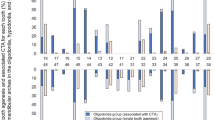Abstract
The aim of this study was to explore the patterns of tooth agenesis in Japanese orthodontic patients with bilateral agenesis of mandibular second premolars. A total of 80 Japanese orthodontic patients with 2 congenitally missing mandibular second premolars were selected as the subjects of this study (experimental group). Another 80 individuals without bilateral agenesis of mandibular second premolars were collected for comparison (control group). The 2 groups were matched with regard to sex. Radiographs, dental casts and records of medical and/or dental treatment were used to identify tooth agenesis. The Chi-square test, odds ratio, and test for equality were used to make statistical comparisons. The prevalence rates of other types of tooth agenesis were significantly higher in the experimental group than in the control group. The occurrence of agenesis of maxillary and mandibular lateral incisors and third molars, and maxillary second premolars was also significantly higher in the experimental group than in the control group. Significantly increased prevalence rates of symmetrical tooth agenesis, with third molars included, and oligodontia were observed in the experimental group. Japanese subjects with bilateral agenesis of mandibular second premolars are at significantly high risk of agenesis of other types of permanent teeth, symmetrical tooth agenesis and oligodontia.
Similar content being viewed by others
References
Ingervall B, Seeman L, Thilander B. Frequency of malocclusion and need of orthodontic treatment in 10-year old children in Gothenburg. Swed Dent J. 1972;65:7–21.
Niswander JD, Sujaku C. Congenital anomalies of teeth in Japanese children. J Phys Anthropol. 1963;21:569–74.
Endo T, Ozoe R, Kubota M, Akiyama M, Shimooka S. A survey of hypodontia in Japanese orthodontic patients. Am J Orthod Dentofacial Orthop. 2006;129:29–35.
Buenviaje TM, Rapp R. Dental anomalies in children: a clinical and radiographic survey. J Dent Child. 1984;51:42–6.
Hunstadbraten K. Hypodontia in the permanent Dentition. J Dent Child. 1973;40:115–7.
Grahnen H. Hypodontia in the permanent dentition. Odont Revy. 1956;7(Suppl 3):1–100.
Nordgarden H, Jensen JL, Storhaug K. Reported prevalence of congenitally missing teeth in two Norwegian countries. Community Dent Health. 2002;19:258–61.
Backman B, Wahlin YB. Variations in number and morphology of permanent teeth in 7-year-old Swedish children. Int J Paediatr Dent. 2001;11:11–7.
Castaldi CR, Bodnarchuk A, Zacherl WA. Incidence of congenital anomalies in permanent teeth of a group of Canadian children aged 6–9. J Can Dent Assoc. 1966;32:154–9.
Silverman NE, Ackerman JL. Oligodontia: a study of its prevalence and variation in 4032 children. J Dent Child. 1979;46:470–7.
Garib DG, Peck S, Gomes SC. Increased occurrence of dental anomalies associated with second-premolar agenesis. Angle Orthod. 2009;79:436–41.
Baccetti T. A controlled study of associated dental anomalies. Angle Orthod. 1998;68:267–74.
Peck S, Peck L, Kataja M. Concomitant occurrence of canine malposition and tooth agenesis: evidence of orofacial genetic fields. Am J Orthod Dentofacial Orthop. 2002;122:657–60.
Shalish M, Peck S, Wasserstein A, Peck L. Malposition of unerupted mandibular second premolar associated with agenesis of its antimere. Am J Orthod Dentofacial Orthop. 2002;121:53–6.
Garib DG, Alencar BM, Lauris JRP, Baccetti T. Agenesis of maxillary lateral incisors and associated dental anomalies. Am J Orthod Dentofacial Orthop. 2010;137:732.e1–e6.
Garn SM, Lewis AB. The relationship between third molar agenesis and reduction in tooth number. Angle Orthod. 1962;32:14–8.
Garn SM, Lewis AB. The gradient and the pattern of crown-size reduction in simple hypodontia. Angle Orthod. 1970;40:51–8.
Celikoglu M, Bayram M, Nura M. Patterns of third-molar agenesis and associated dental anomalies in an orthodontic population. Am J Orthod Dentofacial Orthop. 2011;140:856–60.
Abe R, Endo T, Shimooka S. Maxillary first molar agenesis and other dental anomalies. Angle Orthod. 2010;80:1002–9.
Endo S, Sanpei S, Takakuwa A, Takahashi K, Endo T. Mandibular lateral incisor agenesis in a Japanese population and the occurrence of associated dental anomalies. J Dent Child. 2012;34 (in print).
Rolling S, Poulsen S. Oligodontia in Danish school children. Acta Odontol Scand. 2001;59:111–2.
Peres RC, Scarel-Caminaga RM, do Espirito Santo AR, Line SR. Association between PAX-9 promoter polymorphisms and hypodontia in humans. Arch Oral Biol. 2005;50:861–71.
Lidral AC, Reising BC. The role of MSX1 in human tooth agenesis. J Dent Res. 2002;81:274–8.
Frazier-Bowers SA, Guo DC, Cavender A, Xue L, Evans B, King T, Milewicz D, D’Souza RN. A novel mutation in human PAX9 causes molar oligodontia. J Dent Res. 2002;81:129–33.
Banks HV. Incidence of third molar development. Angle Orthod. 1934;3:223–33.
Nanda RS. Agenesis of the third molar in man. Am J orthod. 1954;40:689–706.
Grahnen H. Hypodontia in the permanent dentition. Odont Revy. 1956;7(Suppl 3):1–100.
Conflicts of interest
The authors declare that they have no conflict of interest.
Author information
Authors and Affiliations
Corresponding author
Rights and permissions
About this article
Cite this article
Endo, T., Sanpei, S., Komatsuzaki, A. et al. Patterns of tooth agenesis in Japanese subjects with bilateral agenesis of mandibular second premolars. Odontology 101, 216–221 (2013). https://doi.org/10.1007/s10266-012-0080-3
Received:
Accepted:
Published:
Issue Date:
DOI: https://doi.org/10.1007/s10266-012-0080-3




